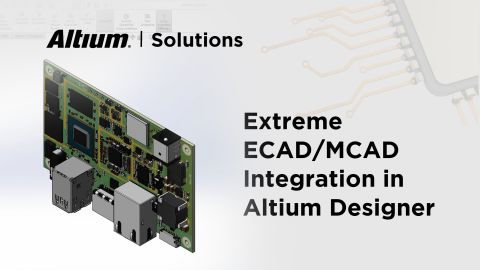It's a Converging, Electromechanical and Software World
Software is eating the world.
It’s making its way into traditional, mechanical products, thus forcing companies to rethink their design process. Products that have traditionally been mechanical are becoming jam-packed with software. This expansion of smart, connected products means new demands for engineers, and branching out into new fields. There is a need for a broader set of design skills among engineering staff and a need for more efficient tools to help them. In this post, we’ll talk about how and why this trend is shaking up the engineering industry.
Anatomy of a Smart, Connected Product
Before we dive in, it’s important to know just what kind of products we’re dealing with. What makes up a smart, connected product anyway? First, you need some sensors so it can perceive and interact with its surrounding environment. These sensors could be for sound, visuals, or temperature. You have embedded systems with consist of circuit boards and processors. Antennas allow the product to connect with IoT. Electromechanical parts (such as actuated machinery and hydraulic components) enable smart, connected products to have some control over their environments. Harnesses bring all of the electrical components together by way of wires and cables. Here, it’s determined what wires are needed and how to route them through the mechanical aspects of the product. Finally, an IoT platform collects data and opens it up to analysis and machine learning algorithms.
Demand for Broader Design Skills
As more electronics make their way into traditional mechanical products, engineers are taking on multiple roles. They have to wear all the hats. Getting newer, more complicated electrical systems into less sophisticated mechanical components is not easy. Mechanical parts, such as something in your bike or your car, have been around for quite some time. Increasingly complicated electrical systems? Not so much. Software is going into everything. It’s in your fridge, it’s in your lamp, and it’s in your car when it brakes on its own.
As you can see, these new types of products require a lot more collaboration between electrical and mechanical engineers than past endeavors may have. In smaller organizations especially, mechanical engineers are casual practitioners of many other engineering domains and don’t have deep expertise in these new areas.
The Right Toolset
Knowledge in multiple engineering domains is useful but can also be problematic. If there is a problem with the design, team members may not have the expertise to address them. What if there is a short on board? What if there are signal integrity issues? Could they identify the issue? Could they solve it?
For the times when engineers might need to work out of their comfort zone, there must be easy-to-use, readily accessible tools available. If a mechanical engineer must work on board design, it will be infrequently and inconsistently. They won’t be doing this all day every day, but maybe a few days per month. They don’t have the time to learn something new and complex. A toolset that can be learned and used quickly needs to be available.
To shorten development times and keep things moving quickly, mechanical engineers need to start exploring board design and electrical systems design, even if it starts on a small scale. They might get a contractor to do some of it, but an engineer (typically a mechanical engineer) in their company needs to oversee it, even if a contractor does most of the work. As a result, mechanical engineers need to get up to speed quickly on electronics and electrical design.
Design for manufacturability is also essential. Mechanical engineers won't know how to make easily manufacturable boards. They need to use tools that aid them here, guiding them through the basics. Another need is for rule checks and analysis. Mechanical engineers won't know how to follow good practices for trace routing and component placement, nor will they know how to perform power and signal integrity analysis. They need tools that help them do this in an automated way.
Summary
Traditional products will only become more complicated going forward, and engineering organizations must find a way to adapt to these changes. Companies that are on the smaller side must make the most out of fewer resources, which means having engineers wear many different hats and collaborating across different domains. For engineers that are taking on unfamiliar tasks, the right tools must be available. It must enable them to do their jobs quicker and more efficiently to keep up with increasing product demand.












